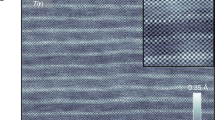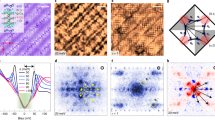Abstract
One leading candidate theory of high-temperature superconductivity in the copper oxide systems is the interlayer tunnelling (ILT) mechanism1. In this model, superconductivity is created by tunnelling of electron pairs between the copper oxide planes — contrasting with other models in which superconductivity first arises by electron pairing within each plane. The ILT model predicts that the superconducting condensation energy is approximately equal to the gain in kinetic energy of the electron pairs due to tunnelling. Both these energies can be determined independently2,3,4, providing a quantitative test of the model. The gain in kinetic energy of the electron pairs is related to the interlayer plasma frequency, ωJ, of electron pair oscillations, which can be measured using infrared spectroscopy. Direct imaging of magnetic flux vortices also provides a test5, which is performed here on the same samples. In the high-temperature superconductor Tl2Ba2CuO6, both the sample-averaging optical probe and the local vortex imaging give a consistent value of ωJ ≈ 28 cm−1 which, when combined with the condensation energy, produces a discrepancy of at least an order of magnitude with deductions based on the ILT model.
This is a preview of subscription content, access via your institution
Access options
Subscribe to this journal
Receive 51 print issues and online access
$199.00 per year
only $3.90 per issue
Buy this article
- Purchase on Springer Link
- Instant access to full article PDF
Prices may be subject to local taxes which are calculated during checkout



Similar content being viewed by others
References
Anderson, P. W. The Theory of Superconductivity in the High-TcCuprates (Princeton Univ. Press, (1997)).
Anderson, P. W. Interlayer tunnelling mechanism for high-Tcsuperconductivity: comparison with c axis infrared experiments. Science 268, 1154–1155 (1995).
Leggett, A. J. Interlayer tunnelling models: implications of a recent experiment. Science 274, 587–590 (1996).
van der Marel, D., Schützmann, J., Somal, H. S. & van der Eb, J. W. in Proc. 10th Anniversary HTS Workshop on Physics, Materials & Applications (eds Batlogg, B., Chu, C. W., Chu, W. K., Gubser, D. U. & Müller, K. A.) 357–370 (World Scientific, Rivers Edge, NJ, (1996)).
Moler, k. A., Kirtley, J. R., Hinks, D. G., Li, T. W. & Xu, M. Images of interlayer Josephson vortices in Tl2Ba2CuO6+δ. Science 279, 1193–1195 (1998).
Loram, J., Mirza, K. A., Wade, J. M., Cooper, J. R. & Liang, W. Y. The electronic specific heat of cuprate superconductors. Physica C 235, 134–137 (1994).
Lawrence, W. E. & Doniach, S. in Proc. 12th Int. Conf. on Low Temperature Physics (ed. Kanda, E.) 361–362 (Academy, Kyoto, (1971)).
Schützmann, J. et al. Experimental test of the inter-layer pairing models for high-Tc superconductivity using grazing incidence infrared reflectometry. Phys. Rev. B 55, 11118–11121 (1997).
Clem, J. R. & Coffey, M. W. Viscous flux motion in a Josephson-coupled layer model of high-Tcsuperconductors. Phys. Rev. B 42, 6209–6216 (1990).
Kirtley, J. R. et al. High-resolution scanning SQUID microscope. Appl. Phys. Lett. 66, 1138–1140 (1995).
Anderson, P. W. c-Axis electrodynamics as evidence for the interlayer theory of high-temperature superconductivity. Science 279, 1196–1197 (1998).
Acknowledgements
We thank M. Bhushan and M. Ketchen for assistance with the development of the scanning SQUID microscope; P. W. Anderson for comments; and P. Stamp for reading the manuscript. K.A.M. acknowledges the support of an R. H. Dicke postdoctoral fellowship. This work was supported by the Netherlands Foundation for Fundamental Research on Matter (FOM) with financial aid from the Nederlandse Organisatie voor Wetenschappelijk Onderzoek (NWO). A.A.T. acknowledges the support of NWO, RFBR and the Russian Superconductivity Program. The work performed at SUNY-Buffalo was partly supported by NYSERDA.
Author information
Authors and Affiliations
Corresponding author
Rights and permissions
About this article
Cite this article
Tsvetkov, A., van der Marel, D., Moler, K. et al. Global and local measures of the intrinsic Josephson coupling in Tl2Ba2CuO6 as a test of the interlayer tunnelling model. Nature 395, 360–362 (1998). https://doi.org/10.1038/26439
Received:
Accepted:
Issue Date:
DOI: https://doi.org/10.1038/26439
This article is cited by
-
Charge trapping and super-Poissonian noise centres in a cuprate superconductor
Nature Physics (2018)
-
Universal linear-temperature resistivity: possible quantum diffusion transport in strongly correlated superconductors
Scientific Reports (2017)
-
Maskless X-Ray Writing of Electrical Devices on a Superconducting Oxide with Nanometer Resolution and Online Process Monitoring
Scientific Reports (2017)
-
Presence of Pseudo-Path in the Interplane Penetration Depth of Layered YBa2Cu3Oy
Journal of Superconductivity and Novel Magnetism (2015)
-
Bi-directional ultrafast electric-field gating of interlayer charge transport in a cuprate superconductor
Nature Photonics (2011)
Comments
By submitting a comment you agree to abide by our Terms and Community Guidelines. If you find something abusive or that does not comply with our terms or guidelines please flag it as inappropriate.



